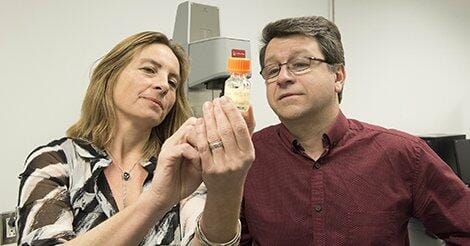Biogel Delivers Anti-Cancer Agents Directly to Tumors

Researchers from the University of Montreal Hospital Research Centre (CRCHUM) have developed an injectable biogel that can deliver anti-cancer agents directly into the tumors. The technique, tested in vitro, consists in encapsulating antitumoral cells or drugs, allowing their direct administration to the tumor area instead of distributing them to the entire body through the bloodstream. The study has been published in the journal Biomaterials.
Anti-cancer treatments are very diverse. One of them, adoptive cell transfer, consists in culturing the patient´s immune cells to improve their immune function and increase their numbers. This system exploits the presence of specific proteins in the cancer cell surface, called antigens. Immune cells can be exposed in vitro to a resected tumor; this allows the immature immune cells to recognize the antigen in the tumor cell surface and primes them to kill other cells presenting the same antigen. Another option is to genetically engineer the immune cell’s genome, introducing a gene that codes for a membrane protein that recognizes an antigen in the target cancer cells. In both cases, after being treated, the cultured cells are injected in the bloodstream and eventually reach the tumor. This technique has worked well in some cases of advanced cancer, but billions of cells need to be injected, and sometimes not enough of them arrive to the tumor. Another problem is the injection on interleukin-2, a hormone that enchances the immune response but can have toxic or off-target effects if administered in excess.
Thermogel: a liquid that solidifies in the body
Dr. Réjean Lapointe hypothesized that delivering the cells and hormones directly to the area where they need to act would improve the effectiveness of the treatment, and it wouldn´t be necessary to inject the currently administered numbers. To that end, he and his team developed a biogel that wraps the anticancer agents and delivers them concentrated to the tumor. They tried several combinations of gelling agents (sodium hydrogen carbonate, phosphate buffer) and chitosan, a material extracted from seashells. They finally found a formulation that allowed the encapsulated CD8+ T lymphocytes to survive and proliferate while retaining their anticancer activity. The gels are liquid at room temperature, which facilitates injection, and become gelatinous at body temperature, keeping the cells together at the injection spot, right in the tumour or beside it.
The thermogels (CTGels) can radically improve cancer immunotherapy. They are biocompatible, have excellent mechanical properties and increase T cell and interleukin-2 effectiveness even at smaller doses. They have worked in vitro against melanoma and cancer cells, and will be tested in animals. In a few years, the CTGels could pass human trials and become a new cancer therapy.
Source: CRCHUM
